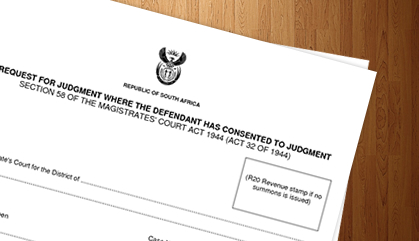Legal Collection Guidelines on Unopposed Matters

Enforcing the collection of Levy Payments
One of the most important functions of trustees is to enforce the collection of levy payments from every owner. When an owner fails to make payment, the trustees hand over the debt for collection. But what is the process of collection once this happens? This depends largely on whether the owner opposes the matter or not.
Attorneys Otto Krause Inc. have provided the following basic guideline of the steps which are followed in a case which is not defended by the owner. Please bear in mind that the timeline may vary as the processes are not always within the control of the attorney.
Where a case is opposed by the owner, the matter becomes far more complex and the attorney concerned should be consulted for a realistic timeline.
01Step 1 – Instructions
- Receive instructions to proceed with legal action.
- Open attorneys office file for this new instruction on Attorney internal system.
- Letter to client wherein acknowledge receipt of new instruction.
- Letter of demand to Debtor.
- Reaction from debtor sent to client for instructions.
- Settlement instructions received and handed to Attorney for finalisation.
- No settlement achieved, consequently advised client and handed to Department for Summons.
02Step 2 – Summons
- Drafted Summons and Particulars of claim, print and handed to attorney for perusal and signature.
- Deliver Summons to Court to be issued by the Clerk of the Court.
- Receive issued Summons back from the Clerk of Court with allocated case number.
- Sent issued Summons to the Sheriff for service thereof on the Debtor.
- Received return of Service from Sheriff and sent copy thereof to Client. Also requested clients instruction on non service and appointment of tracer.
- Tracer appointed on “no trace, no fee basis”.
- Trace report received and sheriff instructed to serve improved summons again.
03Step 3 – Judgement
- Letter sent to client requesting instructions to proceed with Default Judgment on laps of 10 days after good service of summons (prescribed period).
- Instruction to proceed with application for Default Judgment received from client.
- Draft application for Default Judgment.
- Application for Default Judgment delivered to court.
- Attend Court to follow up if Judgment has been granted, or attend queries, if necessary.
- In so far as is required, we attended Court and addressed all queries that the Court had regarding Request for Default Judgment.
- Sent letter to client advising that Default Judgment has been granted with date thereof.
04Step 4 – Warrant of Execution of Movables
- Send Letter to client for authorisation request that we may proceed with Warrant of Execution against the Debtor for Judgment amount.
- Received written instructions from client to proceed with Warrant of Execution.
- Warrant of Execution, drafted, printed, signed and Sent to the Clerk of the Court to be issued.
- Received warrant back from court duly issued and instructed sheriff to execute warrant.
- Receive Sheriffs return of Service.
- Forward Indemnity to client for signing, if necessary.
- Received signed Indemnity from client and forward same to Sheriff.
- Tracer appointed on “no trace, no fee basis”.
- Trace report received drafted re-Issued warrant and sent to court to be issued.
- Received Re-issued Warrant from court and instruct Sheriff to execute Warrant.
05Step 5 – Sale of Movables
- Receive return of Service from Sheriff, with list of Debtors assets attached in execution. Sent letter to client to advise and indemnify Sheriff.
- Follow up with client to provide indemnity.
- Received indemnity from client and sent to Sheriff to remove and sell the assets that he attached.
- Follow up with Sheriff to provide auction date.
- Received sale (auction) date from the Sheriff and reported the date to client.
- Draft full and detailed conditions of sale and forward to Sheriff.
- Advertised auction sale of Debtors assets in local newspaper.
- Receive Sheriff’s cheque for proceeds of auction sale of Debtors movable assets and account to client.
06Step 6 – Warrant of Immovables
- Receive sheriff return of “nulla bona” alternatively four (4) non trace reports.
- Take instruction to proceed with Application [66(1)(a)] to sell immovable property (Unit).
- Affidavit in terms of Section 66(1)(a) to client – sign before commissioner of oaths.
- Client return affidavit to our offices.
- Prepare Application in terms of Section 66(1)(a) for sale of Immovable Property.
- Send Application in terms of Section 66(1)(a) to Sheriff for personal service.
- Receive return of service from Sheriff.
- Attend court on set down date to Argue Application in terms of Section 66(1)(a).
- Application in terms of Section 66(1)(a) – Successful.
- Application in terms of Section 66(1)(a) – Unsuccessful.
07Step 7 – Sale of Immovables
- Prepare Warrant of Execution against immovable property, print and signe.
- Receive issued Warrant of Execution from the Clerk of the Court.
- Prepare Conveyancer Certificate, print and sign.
- Warrant to Sheriff for attachment of immovable property.
- Receive return of Service from Sheriff.
- Warrant to Sheriff for service on registered bondholder, if applicable.
- Request sale date from Sheriff.
- Follow up with Sheriff regarding sale date.
- Prepare sale condition and forward to Sheriff.
- Advertise sale in local newspaper and Government Gazette.
- Follow up with local newspaper and Government Gazette.
- Await auction.
- Report to client.
08Step 8 – Completion
- Report to client re completion of the matter and request instructions.
- Take instruction to proceed with Settlement discussions.
- Take instruction to proceed with sequestration.
- Take instruction to proceed with Section 65 steps.
- Take instruction to proceed with emolument attachment application.
- Take instruction to proceed with closing of file.
- Final Comments.

